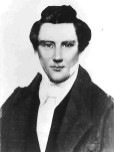
FAIR is a non-profit organization dedicated to providing well-documented answers to criticisms of the doctrine, practice, and history of The Church of Jesus Christ of Latter-day Saints.
| Line 25: | Line 25: | ||
*{{CriticalWork:Stenouse:Rocky Mountain Saints|pages=164n.}} | *{{CriticalWork:Stenouse:Rocky Mountain Saints|pages=164n.}} | ||
Brodie says that Stout's story "is confirmed" by Stenhouse, but Stenhouse mentions no names. | Brodie says that Stout's story "is confirmed" by Stenhouse, but Stenhouse mentions no names.{{ref|quinn.194}} | ||
===New wrinkle: Hofmann forgeries=== | ===New wrinkle: Hofmann forgeries=== | ||
| Answers portal |
| Joseph Smith, Jr. |

|
|
|
|
|
This page is based on an answer to a question submitted to the FAIR web site, or a frequently asked question.
There are two basic 'streams' of this theory.
The first derives from Fawn Brodie (1945):
Other authors have followed Brodie. Abanes (One Nation Under Gods), for example, merely quotes Brodie as his source.
Brodie's evidence derives from two sources:
Brodie says that Stout's story "is confirmed" by Stenhouse, but Stenhouse mentions no names.[1]
The second evidential stream draws on the first, but adds a new wrinkle. This wrinkle is one of the Hofmann forgeries.[2] Mark Hofmann forged the supposed letter from Joseph to Dunham, and it was published in a collection of Joseph's personal writings before the forgery was discovered. The forged document reads:
Despite the fact that the document is a forgery, some historians have continued to use it. For example, D. Michael Quinn uses it as evidence, and cites the Jessee transcript of the letter (cited above):

FAIR is a non-profit organization dedicated to providing well-documented answers to criticisms of the doctrine, practice, and history of The Church of Jesus Christ of Latter-day Saints.
We are a volunteer organization. We invite you to give back.
Donate Now